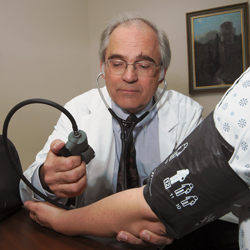Get time on your side: expert tips to eliminate waiting
Resolve to solve the waiting-room back-ups. Find out where the practice falls behind and implement solutions, including time studies, prior preparation and using medical assistants to their highest level of practice.
DENVER—Long waits may be an accepted fact of medical visits for most patients, but not Meryl Luallin. Ms. Luallin has spent a lot of time waiting around doctors' offices in her 15 years as a mystery patient, but as a consultant and physician “shadow coach,” she's also taught practices how to run on time to improve patient satisfaction. As a partner in Sullivan/Luallin, Inc., she provides consulting on marketing and customer service to medical practices.
She shared some strategies for eliminating wait times during a session at the Medical Group Management Association's annual meeting in October. The first step to solving a delay is finding the points where the process backs up, Ms. Luallin told attendees.
“You need to do a time study,” she said. “When a patient walks in, hand her a card.” The card explains that the office is doing a time study and asks the patient to note the time at each phase in her visit—arrival, registration, rooming, seeing the doctor, checkout. At checkout, the patient turns in the anonymous data.
Late patients, later doctors
Once a practice has found its delay points, it can implement solutions. Anti-waiting strategies begin even before the patient enters the office, Ms. Luallin said. “Schedule realistically,” she suggested. “I shadowed a doctor whose schedulers scheduled new patient visits for 15 minutes.”
Schedulers can also get a jump on the registration process, by taking patient information over the phone or sending registration forms in the mail. Or, if your patients are tech-savvy, you can instruct them to download registration forms from a Web site and complete them before they arrive.
Many doctors complain that they get behind because patients are late for their appointments. Ms. Luallin has a simple solution. “If you want patients to be on time, tell them that's your policy. ‘If you're going to be more than 10 minutes late, we will have to reschedule you.’”
Of course, patients will likely only obey these instructions if they're actually seen on time. “If you are an obsessively on-time physician, then you have a right to put a policy in the exam room that says we like to stay on time.”
As for how to become a practice of on-time physicians, Ms. Luallin had a sneaky strategy for schedulers. “It is stealth scheduling. Nobody schedules a patient for 8 o’clock if the doctor doesn't show up until 8:15.” Even showing up at the same time as the first appointment may be insufficient, because greeting coworkers, drinking coffee and checking e-mail are usually enough to put you behind schedule, she noted.
Roomed and bored
The common excuse that it takes a long time for the patient to be roomed can be eliminated with on-time incentives like those used by airlines. “If you call the staff together and say there's a reward for getting that patient in at 8:05, you won't have that problem again,” Ms. Luallin said. The patient's chart should also have been prepped, either earlier in the morning or the night before, and supplemented with any patient education that's likely to be needed.
Of course, no matter how hard you try, the patient is going to have to wait at some point and he'd probably rather do that in your pleasant, well-equipped reception area (“Never call it the waiting room,” warned Ms. Luallin) than the exam room. “If your patients are waiting in the exam room for longer than 10 minutes, they have been roomed too early.”
One practice found a simple, cheap solution to enforcing that rule. They bought timers and clipped them to the exam room doors. “When the patient is roomed, the medical assistant clicks it to [go off] in 10 minutes,” explained Ms. Luallin. When it does, the medical assistant (MA) goes in to check on the patient and update her on how long the wait will be. During a long delay, Ms. Luallin said, it's also helpful if the doctor peeks in between patients to apologize and give an update.
Advance work
Before the doctor begins the visit, MAs can do a lot of time-saving advance work. “Part of the secret to having docs stay on time is a well-trained, motivated MA,” Ms. Luallin said. “Doctors should never ever walk into an exam room without knowing what a patient expects out of that visit.” In addition to getting the patient's problem list, the MA should be trained to go through the medication list, she suggested.
A doctor's lack of awareness of what the patient wants out of a visit is a major cause of delays, Ms. Luallin said. The process of getting that information should begin at check-in, with a form that asks for a list of the issues that the patient would like to discuss during the visit. The MA should ask, too, and then the doctor should do an additional quick run-through with the patient to avoid any hand-on-doorknob surprises.
Keep probing even if you already know the main and even secondary complaint, Ms. Luallin advised. “Here's what the doctor needs to say: ‘Before we discuss that, is there anything else? All right, if we have time, we'll talk about that. Is there anything else?’”
It's OK to tell the patient that there's not enough time in the visit to address everything, and prioritize based on what seems most medically important. If you see that the patient is carrying a list, get control of it. “The typical patient with the list doles out one item at a time and the last item may be the most urgent. Get the list away. Even if the patient says, ‘No, you can't read my writing,’ the response is, ‘I'm a doctor. I can read anybody's writing.’”
Don't leave unless you mean it
Assuming that chart prep has been done well, it should then be possible for the doctor to complete the visit without leaving the exam room. “Every time a doctor leaves the exam room, that opens him or her up to interruptions,” said Ms. Luallin. There are only two exceptions to her no-leaving rule: the incurably chatty patient and the needy patient.
Ordinary chattiness can be dealt with by a polite interruption: “May I ask you a couple of questions?” Needy patients who want to cry on your shoulder about their divorce, for example, may require a firmer response, Ms. Luallin said. “As the patient starts to crumble, put your hand on her shoulder and say, ‘I'm going to let you get control of yourself while I see another patient.’”
If nothing else, there's always the fake-phone-call option, which can be done politely. “Instead of saying, ‘I have to take the call,’ say ‘This is an important call. Do you mind if I take it?’ It makes the patient feel in control.”
Real phone calls, from patients, are another source of delay, and Ms. Luallin offered some strategies for minimizing them. She suggested recapping instructions numerically and in writing at the end of the visit. “If you put it in terms of 1, 2, 3, it's much easier for the patient to recall.”
Then the physician and/or the MA should ask the most dangerous question: Do you have any more questions? “They're so afraid the answer's going to be ‘Yes, I have questions,’” Ms. Luallin said. “You've got to do this. Otherwise the patient will call you.” In case the patient does later find reason to call, he should be given the MA's contact info on a card to divert time-consuming phone calls away from the doctor.
‘Ambulatory’ care—the walk-in
Once you've gotten the regularly scheduled patients in and out, there's only one thing left to ruin on-time performance—the walk-in. However a practice decides to deal with walk-ins, it should be consistent. “If you choose not to accept walk-ins, you should make it a policy and promote that policy. Have a poster saying, ‘We don't accept walk-ins unless it's an emergency. Here is the closest urgent care center.’”
Some practices that do take walk-ins keep to the schedule by assigning one physician to see all of them on a given day. “Every day somebody is the walk-in doctor. They schedule that doctor light,” explained Ms. Luallin.
Or, if no other solution can be found, walk-ins go to the bottom of the pile. “Everyone knows that if you do have a walk-in, they should be put at the end of the schedule,” Ms. Luallin said. Once a practice has mastered the art of running on time, a few walk-ins who are expecting a wait should hardly be a challenge at all.





